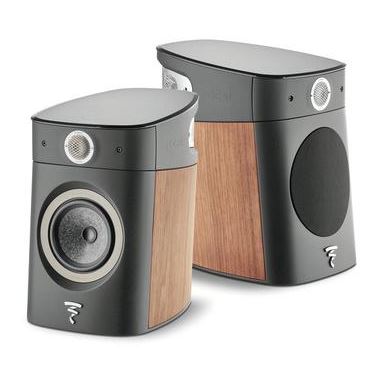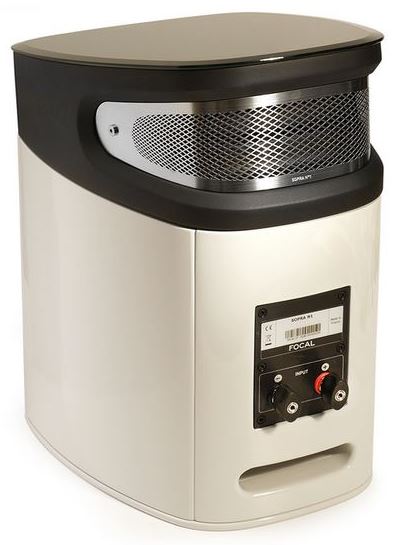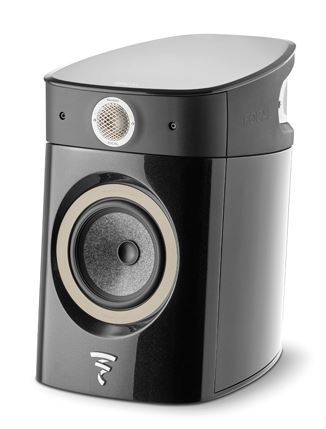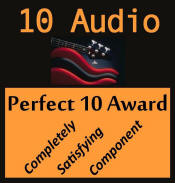Focal of France has been in the loudspeaker business for many years. They are a well-regarded supplier of raw drivers for speaker builders. Many of their drivers are used in commercial products from other loudspeaker manufacturers. Several years ago, Focal introduced a full line of finished loudspeaker systems, ranging from the top-of-the-line Utopia series, the slightly less ambitious Utopia Evo, Sopra, Electra, Aria, and completing the line with the lowest price Chorus series. At the most recent RMAF in Denver in October, 2017, Focal introduced the new Kanta series speakers which are positioned between the Sopra and Electra product lines. And a funny thing happened at that audio show.

There I was, listening to the new Kanta No2 speakers and admiring their good sound and modern appearance when I happened to look at the opposite end of the large room. And over there, sitting silently on their stands, ignored, was a pair of Sopra No1 speakers dressed in the wood grain finish. My preference for speakers is for a modest and unobtrusive appearance blended with engineering excellence to help the speakers disappear in my dimly lit listening room. One of the bright, colorful optional finishes will appeal to some listeners and enhance the speaker’s ability to stand out or fit in with an existing room décor. The more old-school appearance of the wood-grain side panels and flat-black front appealed to this listener. The beveled glass top is an attractive finishing touch. It was love at first sight. The very nice folks from Focal facilitated an on-the-spot purchase and, at the conclusion of the show, kindly helped load them into my Jeep.
Why would anyone purchase loudspeakers without an in-home audition to gain some assurance they would be compatible with the rest of the system? Well, I get a little excited at audio shows, seeing and hearing the new and not-so-new audio toys. If you like amusement park rides, you go to Magic Mountain and Disneyland. If you are an audiophile, AKA audiophool, you go to an audio show, which is almost as effective as sex to get one excited! I had heard the big $ix-figure Focal Utopias a number of times over the years and they never really appealed to me. I was impressed with the Sopra No1 during a brief audition with my music at the RMAF in 2016. And my home theater system employs Focal Chorus 714s and a Focal center channel speaker with good results. So, it was with just a little concern that these unproven, $7000 Focal Sopra No1 speakers were installed in the main audio system.

The large, heavy box for each speaker contains the speakers, removable grilles for the woofers, stands, tools, owners manual, and port plugs. Assembly instructions for the stands are posted on the inside flap of the box. Nice touch! It is recommended that the assembly be performed by two people, but I was able to take care of the assembly solo, working slowly. The speakers are firmly bolted to the heavy steel and glass stands. There is a single pair of binding posts on the rear of each speaker. Thank you, Focal.
Thimages/VPI_Aries_Kuzma_4-Point.jpge review system includes a VPI Aries 3 turntable with a Kuzma 4-Point tonearm, ZYX UNIverse Premium and Miyajima Madake moving coil cartridges; Pass Labs XP-25 and BMC MCCI phono preamplifiers; custom Windows 10 music computer running JRiver Media Center; Bryston BDA-3 DA converter; Lynx Hilo and RME ADI-2 Pro AD/DA converters with external power supplies; Mark Levinson No. 52, PS Audio BHK Signature, and Acoustic Imagery Jay-Sho preamplifiers; Cary CAD-805AE, Inspire Fire-Bottle SE, First Watt J2, PS Audio Stellar S300, Valvet E2, and Pass Labs XA30.8 power amplifiers; Fritzspeakers Carrera BE loudspeakers with the lowest few Hertz supplied by a pair of JL Audio e110 subwoofers, and Focal Chorus 714 loudspeakers borrowed from the HT system. The audio cabling is Audioquest WEL Signature and Mogami interconnects and speaker cables. USB cables include Wyred4Sound USB PCOCC Premium, and Straight Wire USB-F. Power cords include my DIY power cord and Straight Wire Pro Thunder. Power protection and purification are provided by a PS Audio Dectet for the preamplifiers and source components, and a PS Audio Quintet for the power amplifiers. The latter provides remote turn-on and -off of power amplifiers that lack a 12V remote trigger.
Over the years, it seems the best results in my 12 x 19 feet listening room have been realized with stand mounted 2-way speakers. The bass performance of larger 3- and 4-way speakers has varied greatly in this room because the position of the speaker that optimized bass performance was rarely the best position to realize the most realistic soundstage. Much more importantly, a 2-way speaker does not require a crossover between a large woofer and smaller midrange driver. This is very significant and the value cannot be overstated! Crossovers have inherent liabilities which include phase shift and decreased system sensitivity (efficiency). Those crossovers are almost always configured for somewhere in the 200-400 Hz range. Middle C is at 262 Hz, so any phase anomalies around this central midrange frequency are NOT welcome because they alter (distort) the signal, often keeping singers from any chance of sounding real. 2-way speakers are immume to this. All midrange frequencies, from the upper bass to the lower treble, are handled by one driver. The Focal Sopra No1s were initially installed in the same locations that the Fritzspeakers Carrera BEs had regularly occupied for more than a year. The Sopras were moved slightly and the toe-in was changed to obtain the best soundstage.
The Sopra No1s have several things in common with the Carrera BEs. They are both 2-way, stand mounted, rear-ported speakers with beryllium tweeters. The Fritzspeakers have a sensitivity spec of 87 dB and the Sopras are listed at 90 dB. This 3 dB difference should make a noticeable difference in output with the same amplifier power, but in situ, the Sopras were just a small amount louder on the same approximate amplifier power. This is relevant because, as you can see in the list of components above, most of these amplifiers are lower powered, and some are single-ended. Both tube and solid-state amplifiers were used with the Sopras. Single-ended is the best and is the current “Holy Grail” of amplifier design.
The bass from the Sopras, without any augmentation with subwoofers, is very good and is a bit more powerful and room filling than the Carrera BEs, which are as close to full range as a 2-way speaker can be, large Tannoys notwithstanding. Where the Carrera BE’s bass is tighter and a bit more impactful, the Focal’s bass sounds as if a larger woofer is at play. The Focal’s bass is more resonant and presents low level detail somewhat more completely, allowing one to more explicitly hear the bass strings on a stand-up bass or cello. The Sopra No1s cost exactly twice the $3500 (plus stands) Carrera BEs and deliver a nice ugrade over those excellent speakers. Solid performance into the low 40 Hz range was observed, with an in-room 30 Hz at -20 dB. The Sopras deliver low bass, just at a lower volume. That’s a 6 inch woofer for you! If we omit the “small speaker” attribute, the overall bass quality is excellent and fills the room very well.

The coherence of the single driver covering the entire midrange is readily apparent. There is a wonderful clarity and continuousness for all vocals, male and female. There is a warmth and fullness to the midrange that is apparent with all of the amplifiers. This saturated, resonant depth is just the opposite from cold or sterile or lean. A wonderful sonic blessing, it was never – ever – overdone, even with the naturally rich sound of the Cary or Inspire SET amplifiers, nor were the relatively leaner Pass or First Watt amplifiers given an unnatural warmth or loss of clarity. This midrange sounds so correct that the ear relaxes and the music is welcomed in, resulting in a strong connection to the music. THIS IS IT! After many amplifier changes, it is very apparent that this is a superb mid-woofer driver. Significantly, this very developed character blends perfectly with the very high resolution and neutral beryllium tweeter.
The Focal tweeter is a special device. I have suggested that the overall quality of a loudspeaker system is defined by the tweeter. Focal has many years of experience perfecting their drivers, all designed and manufactured in house. The Sopra tweeter is a direct descendent of the Utopia tweeters, using a similar implementation of the Infinite Acoustic Loading technology that appears in the Utopia line. This tweeter has the ability to dig very deeply into the lowest level, smallest detail that is on the recording and sent downstream from your source components. It is just a bit more refined and smoother sounding than the excellent beryllium tweeter in the Carrera BE speakers. Recordings that I thought were familiar constantly deliver new detail or meaning. The Focal tweeter is one of the best available, regardless of technology: ribbon, planar, dome, etc. It is a standout.
My listening room is a good match for the Sopra No1s, although I have no doubt that they could play much louder than I ever drove them. They delivered 90 dB SPLs, C-weighted slow response, at the listening seat with the 25 Watts per channel First Watt J2, and over 100 dB SPL with the very conservatively rated 30 Watt Pass XA30.8. The free NIOSH app (National Institute for Occupational Safety and Health) – search NIOSH SPL – with a calibrated Dayton iMM-6 microphone plugged into my iPhone, showed 102 dB peaks with the 12 Watt (8 Ohms, 20 Watts 4 Ohms) Valvet E2 single ended solid state amplifier. The Valvet E2, review due soon, is an awesome pairing for the Sopra No1, given a compatible room and the listener’s appreciation for more moderate, and healthy, volume levels.

Research has shown that sustained or repeated listening at volume levels in excess of 85 dB can cause permanent hearing damage. Since configuring the smart phone with the NIOSH SPL app and occasionally monitoring my listening levels, I find volume levels around 80 dB SPL to be very satisfying 99% of the time. Check it out!
Application Note: Add a subwoofer or two. Plug the rear ports on both Sopras with the included foam port plugs, and set the subwoofer’s low pass crossover to around 65-70 Hz. The resulting system, properly dialed in, could rival any full range speaker on the planet. Over time, my ever-changing system has regularly included powered subwoofers from various manufacturers, including a couple of DIY subs. These facilitate dialing in just the right amount of bass in the room, and obviate the need to compromise the main speakers’ position for either good bass performance or a good soundstage. My strong preference is to use a subwoofer’s speaker (high) level inputs to maintain the main amplifier’s character in the low bass and optimize the blend with the main speakers. Using the speaker level connection keeps the main speakers and subs dialed in together, so amplifier changes are quick: the subwoofer does not need to be dialed in again. And, an amplifier’s bass performance can be compared to other amplifiers and judged reliably, just as when using a traditional full range speaker system.
There were numerous changes between the tube single-ended triode Cary 805AE, used with Psvane WE211 tubes, and the solid state single-ended First Watt J2. The J2 offered a deeper soundstage and more precise localization of performers on that stage. The Cary amp gave slightly rounder and apparently larger lead singers, with greater individual 3D effect. Early listening suggests that the Valvet E2 amplifier combines the Cary’s tube virtue of rich harmonics with the First Watt’s control and extension.
Listen to the Steve Miller album Fly Like an Eagle. The bells near the end of “Wild Mountain Honey” have never sounded clearer, more distinct, and truer to a real acoustic instrument than I have heard in my listening room in over 20 years. On the 1972 Eat a Peach CD from the Allman Brothers Band, the drum solo on “Mountain Jam”, between the 13 and 19 minute marks, is truly thrilling. Similar revelations from recordings that have been listened to many, many times are in store when these speakers are in your audio system.
With Sopra No1s in the your system, amplifiers or other upstream components that sound coarse or send other sonic garbage downstream will quickly be revealed as inferior. Don’t blame the speaker if your preamp, DAC or other system component no longer sounds so good. The Sopra No1 is a very revealing speaker, but its extreme neutrality is just a window on your music. These speakers do not editorialize that music in any way, but you get it all. The next speaker on this audiophile’s wish list is the upmarket Focal Utopia Diablo. Even though I expect that speaker to be an upgrade, the Sopra No1 still earns the rating below. It does not deserve a lower rating just because there might be something better out there. The Focal Sopra No1 is a highly communicative, extremely entertaining and completely satisfying loudspeaker.
Update July, 2018 – 6 months later: The review is accurate as written. This is a wonderful loudspeaker!
Overall Rating: 10 LPs

Link to manufacturer: Focal
